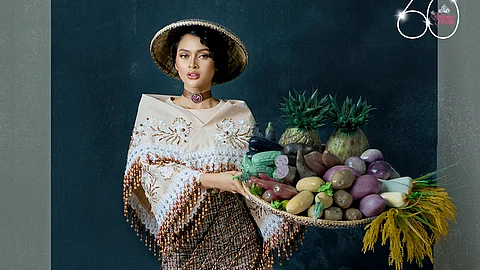
- NEWS
- the EDIT
- COMMENTARY
- BUSINESS
- LIFE
- SHOW
- ACTION
- GLOBAL GOALS
- SNAPS
- DYARYO TIRADA
- MORE

After strutting the runway with their pasarela skills wearing one-piece black Dia Ali swimsuits by Justine Aliman, the 60th Binibining Pilipinas pageant’s preliminaries continued with elegance, sophistication and color during the evening gown and national costume competition. Held on Tuesday, 11 June, at the New Frontier Theater, the 40 candidates wore Filipino gown creations and showcased Filipiniana-inspired costumes.
The mesmerizing fashion show featured craftsmanship by Glennze Mark Aquino, Armand Marco, John Rhon Talain Dalisay, Patrick Isorena, Alfie Desamparado, Marie Linoy, Jessie Gonzales, Odelon Simpao, Uly Montenegro, James O’Briant, Aryel Dulay, Princess Rivera, Francis Deney Lee, Ehrran Montoya, Jun Leonard Rodrigo, Michael Jayzon dela Cruz, Chico Estiva, Kenneth Malayka Yamas, Jerome Navarro, Edwin Uy, Carl John Miranda, Jamijam Jimera, Roy Aquino, Jude Chael, Rhamz Diacoma, Er Stephen Alvarado, Vinze Asuncion, Francis Deney Lee, Louis Pangilinan, Karl Balao, Jomar Peralta and Rich Masangkay, Reynold Tenerife, Alrasid Jailani, Kenneth Dreyfuss Ong, Don Pedro Moises & JP Chua, Axel Que and Richard Strandz.
At the end of the preliminary competition, the top five candidates were selected. They were Oriental Mindoro’s Myrea Caccam (Binibini 16), Quezon Province’s Joyce Anne Garduque (Binibini 23), Kalayaan Laguna’s Monica Acuno (Binibini 24), Cavite’s Zianah Famy (Binibini 31) and Abra’s Myrna Esguerra (Binibini 40).
Michael Jayzon dela Cruz created Myrea Caccam’s costume inspired by Lake Naujan and Dabalistihit Festival of Naujan. A stunning representation of the beauty and cultural heritage of Naujan, Oriental Mindoro, the modern white Filipiniana, drew inspiration from the breathtaking Lake Naujan, known for its tranquil waters and picturesque surroundings. The skirt was crafted from recycled plastic bottles collected from the coastal area of Naujan. It featured intricate designs and patterns reminiscent of the waves and ripples of Lake Naujan creating a mesmerizing visual effect.
The top was adorned with exquisite crystals and pearls, symbolizing the elegance and grace of the community. The shimmering crystals reflected the sunlight, mimicking the sparkling waters of the lake, while the pearls represent the precious cultural heritage and traditions of the Dabalistihit Festival.
The innovative materials used for this modern white Filipiniana was a fusion of environmental consciousness, cultural pride, and artistic craftsmanship. It served as a testament to the beauty and resilience of Mindoro and its people.
Since Quezon Province is known as the “Coconut Capital of the Philippines,” Roy Aquino created a costume to celebrate the rich agricultural heritage and vibrant culture of the region. Joyce Anne Garduque’s costume was from various coconut products, highlighting the province’s abundant resources. The bodice, adorned with coconut shell beads and accents, reflected the region’s thriving coconut industry. The base fabric was woven from coconut husks, traditionally used to create durable sacks.
To emphasize versatility, Aquino used coconut fibers as threads to stitch the costume together. The skirt design drew inspiration from the town of Atimonan, known for its association with mermaids. The intricate patterns on the skirt resembled scales and a mermaid’s tail, creating a mesmerizing visual effect that captured the mythical allure of mermaids. To symbolize the extensive agricultural landscape and pay homage to the farming communities, Aquino used corn husks to create the headpiece. Showcasing a beautiful blend of tradition and innovation and highlighting the sustainable and eco-friendly practices of the region made entirely from dried organic materials, Garduque’s unique ensemble represents the natural beauty, cultural richness and agricultural prowess of Quezon Province.
As the daughter of a farmer from her native hometown, Monica Acuno showcased the enduring legacy of strong Filipina women. Patrick Isorena’s design was an homage to the Kalayaan’s diligent farmers, which featured a vibrant display of fresh fruits and vegetables arranged in a basket. The costume symbolized the bountiful agricultural harvest of the land and underscores the abundance of the local produce. The traditional ensemble not only embodied the essence of Filipino culture but also stood as a proud tribute to the deep-rooted customs of the heritage. It sheds light on the indispensable contributions of the women of Kalayaan in nurturing their flourishing agricultural sector.
Celebrated every December in Maragondon, Cavite, Zianah Famy’s ensemble by Karl Babao featured the Kawayan Festival. Made from Banig, the upper bodice was intricately patterned symmetrically, combined with Kawayan strip detailings for the accessories. Made from a rectangular Kawayan tassel, the lower bodice was painstakingly sewn individually, creating an amazing sound of chimes, which made the creation remarkable and an absolute standout.
Named after an epic heroine of the Tinguian people of Abra, embodying the quintessential qualities of a great Abrenian, Richard Strandz crafted the Dulimaman masterpiece. Through her legendary tales, Dulimaman continues to inspire and uphold the rich heritage and resilient spirit of the people of Abra. Myrna Esguerra exemplified beauty, compassion, courage, strength and wisdom, serving as a powerful symbol of the cultural and moral values cherished by the Tinguian community. This piece is dear to her heart as it reminds her of home. This ensemble is also a tribute to her mother who has been a dedicated basket weaver for a decade and single mother of 13 children. Her unwavering commitment to her craft and her family exemplifies the enduring spirit and skill of Abrenios. It honors her remarkable journey and the cultural heritage she embodies.
The winner of Best National Costume will be announced during the 60th Binibining Pilipinas pageant on Sunday evening, 7 July at the Smart Araneta Coliseum. The much-awaited grand coronation will be hosted by Miss Universe 2018 Catriona Gray, Miss International 2016 Kylie Verzosa, Binibining Pilipinas Universe 2014 Mary Jean Lastimosa and Binibining Pilipinas Grand International 2016 Nicole Cordoves.
